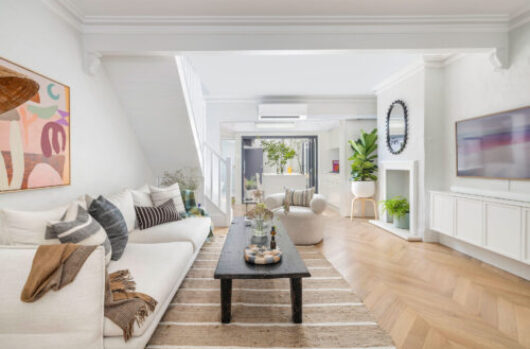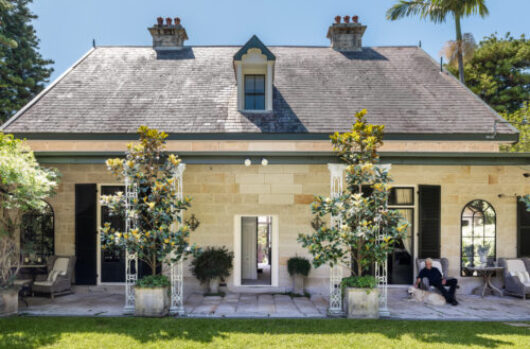Talking shop: Myles Baldwin – horticulturalist
Myles Baldwin’s been dubbed ‘the Bondi vet of gardening’, the poster boy for a whole métier. A trained horticulturalist, Myles cut his teeth working with Leo Schofield on the historic gardens of Bronte House. He’s also replanted The Swifts estate at Darling Point and reappointed the gardens of iconic Spanish Colonial Boomerang, Elizabeth Bay. But Myles is not just about bigger being better. His new house in Alexandria, on a tight corner site, is a case study in small garden planting. He’s also a whizz with a few pots on a tight terrace. We sat down with Myles to get the lowdown on inner city gardening.

“We’d been living in Elizabeth Bay opposite the Boomerang estate, which allowed me excellent views onto the period garden I was asked to redesign. We had a potted balcony garden, mostly Japanese box balls, flowering ginger, bamboo. You could barely sit out there, it was such a tight squeeze. The decision to move was really about acquiring more space. We’re both in our 30s, kids possibly around the corner, the business was growing, it was the right time to move out of the inner East. Alexandria seemed to have all the cool of Surry Hills, without the high prices.”
“When I saw this place, a California bungalow on a corner block with a studio space out the back converted from old stables, it just seemed perfect. The layout of the house is really lovely. An entry vestibule gives into a library/dining room, I love dining among books, it feels so serene. We’ve kept it minimal on the ground floor – but we collect things, pot plants, books, so it’s always a challenge to not end up in clutter. I find that when I’m on site working, I pick up all sorts of stuff, rocks, pebbles, shells, just anything I find intriguing or beautiful. Inspiration can come from so many places in nature. I also collect photographs by Gary Heery, whose work I really admire. We’re working together on a project at the moment, plucking trees out of the ground and photographing them on a white background.”
“And I have a garden! It’s divided into three zones – the front entrance plot, the side walkway and the rear courtyard between the house and the studio. It’s not big, just 48 m2 but small gardens are more difficult to design than large ones, you have so many parameters to consider. Small gardens create micro climates, and that restricts what you can grow.”
“When planning a garden, I think of texture and colour and performance. But I don’t think I have a ‘style’ as such, something you might brand. I don’t want to punch out any particular style of garden, it’s more about being responsive to site and to client requirement.”
“I think of my gardens as giant flower arrangements. At the front of my house, as ground cover I’ve planted Helleborus, Epimedium and Geranium maculatum. As shrubs, Daphne, Hydrangea and Viburnum. I lucked out on the existing tree, a Sophism sebiferum, which I have always wanted. Along the side walkway, I’ve planted mixed climbers – Jasmins nitididum and azoricum, Stephanotis floribunda, Pandorea pandorana – and as ground covers Pachysandra terminals and Hakinechloa aurea. Ball-shaped Buxus shrubs punctuate the walk.”
There’s more light and air in the courtyard, a bit more room to breathe, so I’ve retained the existing Frangipani and added some Buxus and Alinia shrubs and Podocarps hedging. I’ve even redone my nature strip. You don’t have to go to specialist garden shops to get interesting plants. In fact, a lot of my plants come from Bunnings. Scarily enough, they’re very good at picking trends – and it seems that if Myles Baldwin or (Melbourne gardener) Paul Bangay are buying 1000s of pots of something for clients, Bunnings think they might be onto something!”
Myles’ tips for small gardens:
1. Set yourself a theme, this will help you choose plants and materials and save you creating a jumbled mess
2. Small spaces deserve good materials, you don’t have a lot of area to cover, so treat yourself to a beautiful paving detail or a high level of finish
3. Contrast plant material; most plants are green so contrast with grey and burgundy foliage and don’t hesitate to try extremes such as succulents and perennial grasses or hedges and arums
4. Oversize plant material and pots make a great impact in small spaces
5. Consider all outdoor space as an extension of your house and design the garden to be usable or as a feature viewed from inside
6. Choose hedges with plenty of texture, Podocarpushenkelii, Magnolia Teddy Bear and Carpinus are all textual species
7. If you must grow edible pants use pots en masse, 1 species per pot (it gives the design a florist kind of feel)
8. Don’t try to grow grass in small areas, lawns typically need sun and small amounts of traffic to be successful.
Photography by Aimee Crouch.






